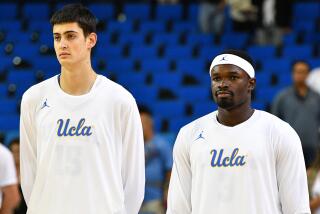American Basketball Players Find Brazilian Game Resembles Hockey
- Share via
RIO DE JANEIRO, Brazil — Chris Weinans has played basketball for 15 years. But it took him 12 games in Rio de Janeiro to find out how brutal the game can be.
The Salt Lake City native has been poked, kicked elbowed, uppercutted, kneed and outright tackled more times in more parts of his 6-foot-7 frame than in his decade and a half of high school, college and European ball.
“Sometimes you feel like an old boxer after a game,” said the sandy-haired, 27-year-old Iowa University graduate. “Back home these guys would be charged with assault, let alone fouls.”
Weinans has painfully discovered what roughly two dozen other Americans who make a living playing Brazilian semipro ball grumble about: Basketball in Brazil is as rough as ice hockey.
Even so, most Americans stick out a season or two. Some, passed over in the National Basketball Association draft, dream of gaining experience in this 2,000-player league before making it in the NBA. Then there are those who simply come to play ball and sample samba, Carnaval and near-nude beaches.
Others who were top prospects in college but feel they’ll never quite make the NBA, like Rocky Smith, a 6-foot-2 guard from Oroville, Calif., stay on. Smith, who played one year in Rio before moving to Sao Paulo, the nation’s largest city, for a four-year stint, has become somewhat numbed to the hatchetry.
“It gets ugly,” the Oregon State graduate said with a breezy bluntness. “You gotta play rough. Even if it means taking three or four fouls to get back at the cat that hit you.”
“Look, that’s the game here,” Fabio Egypto, president for Fluminense, Rio’s top team in 1988, said as he watched his team play rival Flamengo one recent evening. “A lot of physical contact is allowed on the court by the referees.”
His eyes widened as he watched a Flamengo forward reach over the top of Weinan’s forehead from behind, dig two fingers into the American’s eyes and snap his head back. Weinans, clutching his eyes, crumpled to the floor in pain.
The referee, several feet away, blinked his eyes. But no whistle. the forward hopped over Weinans like a cat, scooped up the loose ball and flung a pass up court.
“Well,” the club president coughed, fingering his collar. “Maybe, in the case of Americans, a little more contact is allowed.”
Several coaches, usually those with American players, are frustrated by the hit-and-run tactics.
“It’s pure resentment,” said Tude Sobrinho, head coach of Fluminense. “The refs and the goons on the other teams are trying to show the ‘gringos’ they won’t let them play the way they did in the States.”
“When they’re in there, it’s no normal game.”
But the occasional court mugging is the short of it. There are the sometimes-biased referees. There are the fans who scream obscenities in accented English. There are the language goofs with fellow players and coaches.
And then there’s the Brazilian talent.
Brazil proved it was no pushover two years ago in Indianapolis when it knocked off the mighty U.S. crew in the Pan American Games.
And though Brazil has no true pro league, some 150 teams compete each year in state-wide tournaments and in a national championship.
These semipro teams are sponsored by large, privately owned sports clubs, which also run the nation’s top professional soccer teams. The soccer teams, which draw crowds of up to 100,000 fans a match, carry much of the glory of the clubs’ names. But the clubs feel obligated to support teams in other sports as well.
Still, Brazilian basketball rivalries are hot.
To fill holes in the starting lineups with fresher, taller talent, clubs with extra cash draft American players.
But not every club can afford the price tag of a “gringo,” whose salary can reach $1,500 a month, plus travel and living expenses. It’s a steep bill considering an average Brazilian basketballer makes between $60 and $80 a month.
“And the big Americans eat a lot too,” chuckled Sobrinho, a 40-year veteran coach in Brazil.
The difference in salaries, plus the fact that some clubs can afford an American, brings the rivalries to a boil. In those cases, the foreigner becomes the butt of the players’ and fans’ hostility.
“You defend your body,” said Weinans. “Then you defend your hoop.”
Such is the creed for most U.S. hoopsters. Joe Manley, a brawny 31-year-old forward from Swainsboro, Ga., put on eight pounds and lifted weights after joining team America in Sao Paulo two years ago.
“There’s something about bigger arms that keeps the flies off your back,” the University of South Western Louisiana graduate said.
Some teams keep a meaty bouncer-type on the roster just in case. Others use alternative measures to gear up Americans for league style.
“In practice my own teammates wrap their arms around me,” said Manley. “You know what they say? Get used to it -- it’s what you’ll get in the game.”
One Rio player claimed to discover the key to elbow-free play.
“You buy the referees a few beers after a game, maybe send them a bottle of wine for Christmas,” said the player. “Then if anybody tries anything funny in the game, you at least get a whistle.”
At times the Portuguese language barrier between American and referee makes for rocky court diplomacy. And when blood boils over a call, confrontations erupt.
“You know, the kind that lead to a few technical fouls,” conceded Marino Marella, coach for Sao Paulo state playoff contender Rio Preto. “Or maybe a brawl. Or two.”
On the road, U.S. players tend to see a greater dose of flying elbows and what they call “ghost fouls.”
“Some road games all you get to do is breathe,” laughed George Davis, a boxer-built, 6-foot-6 forward from Vallego, Calif. “And Brazilians can throw you on the floor and not get a call for it.”
Gradually, each player comes up with a personal survival method.
“A pair of leather, spiked gloves and a crash helmet,” said Weinans, a glimmer of a smile creeping across his lips. “Maybe a bodyguard.”
His teammate, Davis, was a bit more conservative.
“A good insurance policy,” he said.
More to Read
Sign up for Essential California
The most important California stories and recommendations in your inbox every morning.
You may occasionally receive promotional content from the Los Angeles Times.













